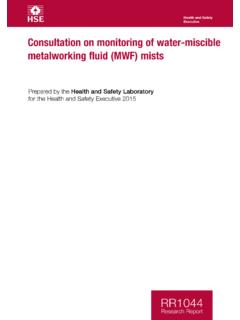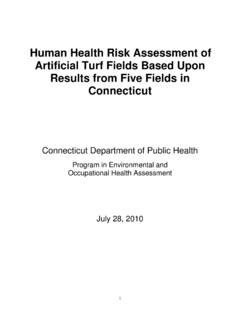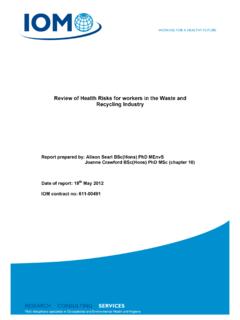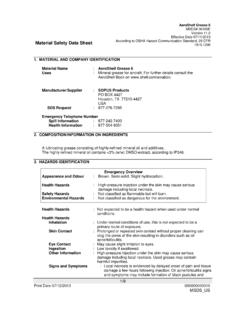Transcription of VOLATILE ORGANIC COMPOUNDS (SCREENING) …
1 NIOSH Manual of Analytical Methods (NMAM), Fourth Edition, 5/15/96 VOLATILE ORGANIC COMPOUNDS ( screening ) 2549 FORMULAsee Table 1MW: see Table 1 CAS: see Table 1 RTECS: see Table 1 METHOD: 2549 , Issue 1 EVALUATION: PARTIAL Issue 1: 15 May 1996 OSHA : PROPERTIES:See Table 1 NIOSH: varies with compoundACGIH:SYNONYMS: VOCs; See individual COMPOUNDS in Table 1 SAMPLINGMEASUREMENTSAMPLER:THERMAL DESORPTION TUBETECHNIQUE:THERMAL DESORPTION, GAS(multi-bed sorbent tubes containingCHROMATOGRAPHY, MASS graphitized carbons and carbon molecularSPECTROMETRY sieve sorbents [See Appendix])FLOW to L/minVOL-MIN:1 L -MAX:6 LINJECTIONSHIPMENT:Ambient in storage containersSAMPLE -DETECTOR (MS): 280 CSTABILITY: compound dependent (store @ -10 C) -COLUMN: 35 C for 4 min; 8 C/minBLANKS:1 to 3 per set300 CANALYTE:See Table 1 DESORPTION:Thermal desorption VOLUME:Defined by desorption split flows (See Appendix)TEMPERATURE-DESORPTION: 300 C for 10 min.
2 To 150 C, 15 C/min toCARRIER GAS:HeliumCOLUMN:30 meter DB-1, ID, mfilm, or equivalentCALIBRATION:Identification based on mass spectrainterpretation and computerized :not applicableESTIMATED LOD:100 ng per tube or lessPRECISION ():not applicablerACCURACYRANGE STUDIED:not applicableBIAS:not applicableOVERALL PRECISION ():not applicablerTACCURACY:not applicableAPPLICABILITY: This method has been used for the characterization of environments containing mixtures of VOLATILE ORGANIC COMPOUNDS (See Table 1). The sampling has been conducted using multi-bed thermal desorption tubes. The analysis procedure has been able toidentify a wide range of ORGANIC COMPOUNDS , based on operator expertise and library searching. INTERFERENCES: COMPOUNDS which coelute on the chromatographic column may present an interference in the identification of eachcompound.
3 By appropriate use of background subtraction, the mass spectrometrist may be able to obtain more representative spectraof each compound and provide a tentative identity (See Table 1).OTHER METHODS: Other methods have been published for the determination of specific COMPOUNDS in air by thermal desorption/gaschromatography [1-3]. One of the primary differences in these methods is the sorbents used in the thermal desorption ORGANIC COMPOUNDS ( screening ): METHOD 2549 , Issue 1, dated 15 May 1996 - Page 2 of 8 NIOSH Manual of Analytical Methods (NMAM), Fourth Edition, 5/15/96 REAGENTS: , : Thermal sampling tube, tube, , high puritymulti-bed sorbents capable of trapping COMPOUNDS of interest for mass spectracompounds in the C-C range.
4 Exact samplerverification (See Table 1).*configuration depends on thermal for preparing spiking solutions: carbonsystem used. See Figure 1 for (low benzene chromatographic grade), sampling pump, to L/min, withmethanol, etc.(99+% purity)flexible tubing.* See SPECIAL chromatograph with injector fitted with 1/4" containers for thermal desorbersampling Instrumentation: thermal desorption system,focusing capability, desorption temperatureappropriate to sorbents in tube (~300 C), and interfaced directly to a GC-MS system. column adapter, 1/4" Swagelok nuts and Teflonferrules (or equivalent). : 1- L, 10- L (liquid);100- L, 500- L (gas tight) Flasks, bulb, 2 LSPECIAL PRECAUTIONS: Some solvents are flammable and should be handled with caution in a fumehood.
5 Precautions should be taken to avoid inhalation of the vapors from solvents as well. Skin contactshould be :NOTE:Prior to field use, clean all thermal desorption tubes thoroughly by heating at or above theintended tube desorption temperature for 1-2 hours with carrier gas flowing at a rate of at least50 mL/min. Always store tubes with long-term storage caps attached, or in containers thatprevent contamination. Identify each tube uniquely with a permanent number on either thetube or tube container. Under no circumstances should tape or labels be applied directly tothe thermal desorption each personal sampling pump with a representative sampler in the caps of the sampler immediately before sampling. Attach sampler to personal samplingpump with flexible :With a multi-bed sorbent tube, it is extremely important to sample in the correct direction, fromleast to maximum strength general screening , sample at to L/min for a maximum sample volume of 6 L.
6 Replacecaps immediately after sampling. Keep field blanks capped at all times. Tubes can act as diffusivesamplers if left uncapped in a contaminated a "humidity test" sample to determine if the thermal adsorption tubes have a high :At higher sample volumes, additional analyte and water (from humidity) may be collected onthe sampling tube. At sufficiently high levels of analyte or water in the sample, the massspectrometer may malfunction during analysis resulting in loss of data for a given sample. a "control" sample. For indoor air samples this could be either an outside sample at the samelocation or an indoor sample taken in a non-complaint area. in sample storage containers at ambient temperature. Store at -10 C. SAMPLE samples to equilibrate to room temperature prior to analysis.
7 Remove each sampler from itsstorage ORGANIC COMPOUNDS ( screening ): METHOD 2549 , Issue 1, dated 15 May 1996 - Page 3 of 8 NIOSH Manual of Analytical Methods (NMAM), Fourth Edition, 5/15 "humidity test" sampler first to determine if humidity was high during sampling (step 10). high humidity, dry purge the tubes with purified helium at 50 to 100 mL/min for a maximum of 3 L atambient temperature prior to analysis.. the sampler into the thermal desorber. Desorb in reverse direction to sampling flow. CALIBRATION AND QUALITY the mass spectrometer according to manufacturer s directions to at least one blank run prior to analyzing any field samples to ensure that the TD-GC-MS systemproduces a clean chromatographic background. Also make a blank run after analysis of heavilyconcentrated samples to prevent any carryover in the system.
8 If carryover is observed, make additionalblank runs until the contamination is flushed from the thermal desorber a log of thermal desorber tube use to record the number of times used and COMPOUNDS unexpected analytes are found in samples, the log can be checked to verify if the tube may have beenexposed to these analytes during a previous sampling spiked samples along with the screening samples to confirm the COMPOUNDS of interest. Toprepare spiked samples, use the procedure outlined in the Appendix . Appendix for conditions. MS scan range should cover the ions of interest, typically from 20 to 300atomic mass units (amu). Mass spectra can either be identified by library searching or by manualinterpretation (see Table 1). In all cases, library matches should also be checked for accurateidentification and verified with standard spikes if necessary.
9 EVALUATION OF METHOD:The method has been used for a number of field screening evaluations to detect VOLATILE ORGANIC of the limit of detection for the method is based on the analysis of spiked samples for a number ofdifferent types of ORGANIC COMPOUNDS . For the COMPOUNDS studied, reliable mass spectra were collected at alevel of 100 ng per compound or less. In situations where high levels of humidity may be present on thesample, some of the polar VOLATILE COMPOUNDS may not be efficiently collected on the internal trap of thethermal desorber. In these situations, purging of the samples with 3 L of helium at 100 mL/min removed theexcess water and did not appreciably affect the recovery of the analytes on the sample. REFERENCES:[1]Health and Safety Executive [1992].
10 MDHS 72 - VOLATILE ORGANIC COMPOUNDS in air. Methods for thedetermination of hazardous substances. HMSO: London: ISBN 0-11-885692-8.[2]McCaffrey CA, MacLachlan J, Brookes BI [1994]. Adsorbent tube evaluation for the preconcentrationof VOLATILE ORGANIC COMPOUNDS in air for analysis by gas chromatography-mass spectrometry. Analyst119:897-902. [3]Bianchi AP, Varney MS [1992]. Sampling and analysis of VOLATILE ORGANIC COMPOUNDS in estuarine airby gas chromatography and mass spectrometry. J. Chromatogr. 643:11-23. [4]EPA [1984]. Environmental Protection Agency Air Toxics Method T01. Rev. (April, 1984): Methodfor the determination of VOLATILE ORGANIC COMPOUNDS in ambient air using Tenax(R) adsorption and gaschromatography/mass spectrometry (GC/MS), Section 13.
















